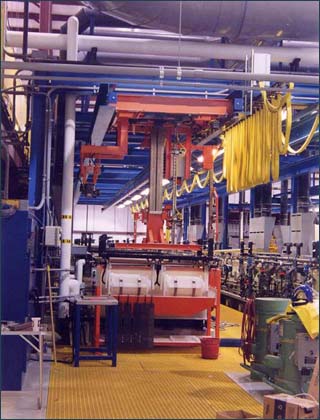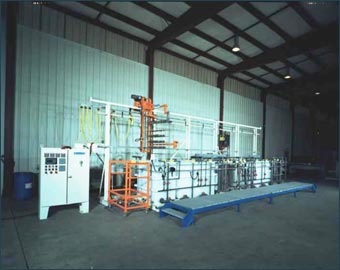Custom Designed Pick and Place Systems
Aqualogic designs and engineers integrated hoist systems for rack, basket, tray, or rotating barrel for new applications or for retrofitting existing manual or automatic lines.
The Aqualogic hoist operates as a manual, semi-automatic, and automatic hoist for use in cleaning, phosphating, hot or cold blackening systems, anodizing, chromate conversion coatings, ecoat, in addition to complete multicycle metal finishing processes.
Hoist capacities ranging from 250 to 1000lbs.
Top running hoist system affords easy access for maintenance.
Hoist line will accommodate an extensive range of tank configurations including ultrasonics. All models include variable frequency motor controllers with adjustable acceleration and deceleration for smooth, controlled stops and starts. Traverse brake wear is virtually eliminated. Laser positioning technology is controlled and monitored through state of the art PLC’s for consistent station control.
User friendly operator interface controllers compliment control systems. Full fault diagnostics are provided with the programming to simplify maintenance. Multiple machine cycles can be stored in the operator interface memory, eliminating continued access to the systems’ programming.


Modular Systems
Modularization includes plumbing for water, steam, and enclosed drains. Systems are assembled for customer approval prior to shipment.
Standard Features
- PLC Control
- Various style hoists; overhead, sidearm or rimrider
- Process monitoring and control
- Variable frequency drive controls
- Self-diagnostics and alarms
- Touchscreen operator interface
- Steam solution heat
- Static load/unload station(s)
- Preventive maintenance prompts
- Variable immersion times
- Automatic
- Semi-automatic
- Manualhoist control
- NEMA 12 hoist and motor control enclosure.
Optional Features
- Machine enclosure
- Laser hoist positioning
- Ventilation
- Ultrasonics
- Baskets, fixtures, racks
- Fixture/Basket rotation or oscillation
- Oil/water separation
- Solution turbulation
- Vertical part agitation
- Solution filtration
- Water conservation
- Gas or electric heat
- Material handling
- Loaders/dumpers
- Parts dryers
- Bar code part entry
- Manually operated monorail hoist
Spare Parts
Pricing for equipment spare parts is available upon request
Contact Us
You can reach us by calling (800) 989-8959 or (203) 248-8959
For Equipment Products please email sales@aqualogic.com
30 Devine St. North Haven, CT 06473
